Catalog excerpts

HIGH-PERFORMANCE WALL SYSTEMS Exterior Wall Solutions for Hot-Humid Climates (Climate Zones 1 - 3)
Open the catalog to page 1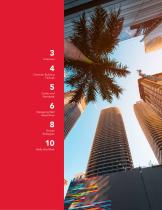
Common Building Failures Designing Wall Assemblies Overall Strategies Walls that Work
Open the catalog to page 2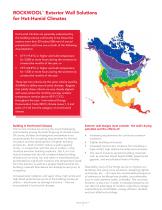
Hot-humid climates are generally understood by the building science community to be those that receive more than 20 inches (508 mm) of annual precipitation and have one or both of the following characteristics: • 67°F (19.4°C) or higher wet bulb temperature for 3,000 or more hours during the warmest six consecutive months of the year; or • 73°F (22.8°C) or higher wet bulb temperature for 1,500 or more hours during the warmest six consecutive months of the year. These last two criteria are the same criteria used by ASHRAE to define warm-humid climates. Regions that satisfy these criteria are...
Open the catalog to page 3
Common Building Failures in Hot-Humid Climates Nearly all building enclosure related failures in hot-humid climates are related to decay associated with water: rain water, ground water, water in the air, and water already in the materials we build with. Image 1: Corrosion of the studs and fasteners on a 7-story concrete and metal framed building in a hot-humid climate, 7 years after the building was completed. The exterior water and air control layer of this building was a mechanically-fastened building wrap that was not detailed to be sufficiently airtight, nor was it sufficiently...
Open the catalog to page 4
The International Energy Conservation Code (IECC) and ASHRAE Standard 90.1 are most commonly referenced by local jurisdictions as well as building certification programs such as the U.S. Green Building Council's LEED. Both the IECC and ASHRAE Standard 90.1 have changed substantially in recent years, making it increasingly difficult for wall systems to comply without including continuous exterior insulation (ci), even in warmer climates. As these codes and standards are adopted - and as occupants and owners demand more energy efficient, thermally comfortable, and quiet buildings - builders...
Open the catalog to page 5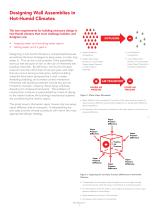
Designing Wall Assemblies in Hot-Humid Climates The two requirements for building enclosure design in Hot-Humid climates that most challenge builders and designers are: • • Vapor Pressure Difference keeping water out (including water vapor) letting water out if it gets in Vapor Pressure Designing in hot-humid climates is complicated because Vapor Difference Pressure sometimes the best strategies to keep water out also trap Difference water in. This can be a real problem if the assemblies Positive start out wet because of rain or the use of inherently wet Air Pressure building materials. By...
Open the catalog to page 6
Understanding Air Transport and Vapor Diffusion Vapor diffusion is the movement of moisture in the vapor state through a material as a result of a vapor pressure difference (concentration gradient) or a temperature difference (thermal gradient). It is often confused with the movement of moisture in the vapor state into building assemblies as a result of air movement. Vapor diffusion moves moisture from an area of higher vapor pressure to an area of lower vapor pressure, as well as from the warm side of an assembly to the cold side, moving through the materials that comprise the wall...
Open the catalog to page 7
Overall Strategy in Hot-Humid Climates Building assemblies need to be protected from wetting by rainwater, ground water, air transport, and vapor diffusion. The typical strategies used involve water control layers (such as membranes, building papers, and house wraps), flashings, overhangs, site drainage, and capillary breaks to control rainwater and ground water. Vapor retarders, air barriers, air pressure control, and control of interior moisture levels (ventilation and dehumidification) are used to minimize wetting by air transport and vapor diffusion. Figures 4a and 4b illustrate the...
Open the catalog to page 8
Ventilated Claddings Ventilation (exterior airflow behind the cladding) is driven by wind pressure differences on the face of the building, or solar heated air rising (“stack effect”). It is useful because it accelerates drying by removing moisture from the drainage space behind the cladding. The ventilation essentially decouples the cladding system (the exterior finish) from the rest of the wall system, and increases the durability of both. Note that providing a ventilated space behind the cladding is included as a strategy that both reduces wetting and maximizes drying in flow-through...
Open the catalog to page 9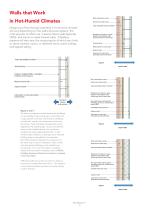
Walls that Work in Hot-Humid Climates Brick veneer/stone veneer Brick veneer/stone veneer Drained and vented cavity Drained and vented cavity Designing a flow-through assembly in hot-humid climates will vary depending on the wall’s structural system, the most popular of which are: masonry block walls (typically CMU), and wood or metal framed walls. Cladding systems will also vary, the most popular of which are: brick or stone veneers, stucco or adhered stone, panel sidings, and lapped siding. Vapor permeable exterior insulation Vapor permeable exterior insulation Membrane or trowel-on or...
Open the catalog to page 10
ROCKWOOL and High-Performance Walls for Hot-Humid Climates Wall assemblies in hot-humid climates must be as forgiving as possible of damp materials, exterior wetting, elevated interior relative humidity, and isolated construction defects. Proper wall assemblies: 1. include continuous air barriers; 2. are constructed without vapor impermeable materials; 3. are designed with an exterior vapor retarder of between 5 and 10 perms ROCKWOOL stone wool insulation products are both non-moisture sensitive and permeable to water vapor whether they are used on the interior or the exterior. This allows...
Open the catalog to page 11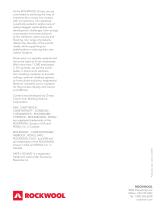
Publication date - edition: 01/2018 At the ROCKWOOL Group, we are committed to enriching the lives of everyone who comes into contact with our solutions. Our expertise is perfectly suited to tackle many of today's biggest sustainability and development challenges, from energy consumption and noise pollution to fire resilience, water scarcity and flooding. Our range of products reflects the diversity of the world's needs, while supporting our stakeholders in reducing their own carbon footprint. Stone wool is a versatile material and forms the basis of all our businesses. With more than...
Open the catalog to page 12All ROXUL catalogs and technical brochures
-
TCB & PWCB CAVITY BARRIERS
6 Pages
-
FirePro® SP FireStop OSCB
7 Pages
-
CLADDING ROLL
4 Pages
-
HARDROCK® MULTI-FIX (DD)
18 Pages
-
High-rise buildings
11 Pages
-
ROCKWOOL® FIREPRO®
109 Pages
-
ROCKBOARD® 40/60/80
6 Pages
-
ROLL,TWINROLL AND ROLLBATT
8 Pages
-
TAPERED ROOFING
8 Pages
-
EWI SYSTEM HOLDERS
8 Pages
-
CAVITY
12 Pages
-
ROCKCLOSE®
8 Pages
-
Commercial Applications
76 Pages
-
FABROCK™ Batt
2 Pages
-
FABROCK™ HD
2 Pages
-
MULTIFIX™
2 Pages
-
ROCKWOOL PLUS™ MB
2 Pages
-
SAFE'n'SOUND®
2 Pages
-
TOPROCK DD®
12 Pages
-
ProRox Pipe products
12 Pages
-
CONROCK®
6 Pages
-
FABROCK™
6 Pages
-
COMFORTBOARD FS
1 Pages
-
Core Solutions
6 Pages
-
CIS
4 Pages
-
COMFORTBATT Steel Stud
4 Pages
-
ROXUL SAFE & CURTAINROCK
8 Pages
-
ROCKBOARD® PG
4 Pages
-
ROCKBOARD®
8 Pages
-
FIREWALL & ROXUL Plus
8 Pages
-
DrainBoard
8 Pages
-
ROXUL AFB®
12 Pages
-
RockFill Brochure
4 Pages
-
propox pipe products catalogue
12 Pages
-
Prorox board products catalogue
12 Pages
-
Core Solutions Brochure
6 Pages
-
Roxul COMFORTBATT
8 Pages












































